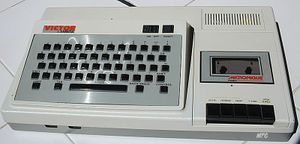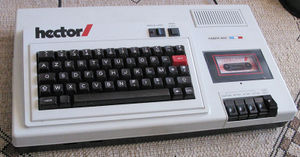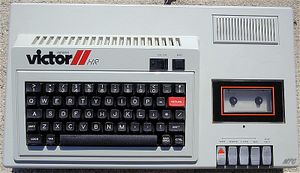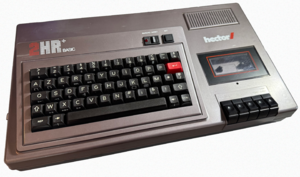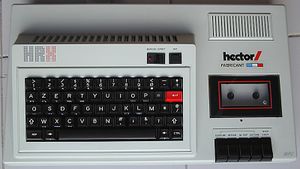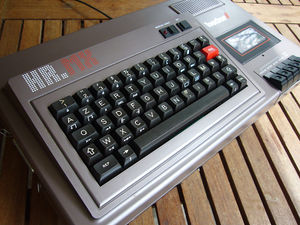Difference between revisions of "Hector"
(→Victor Lambda) |
|||
| (29 intermediate revisions by the same user not shown) | |||
| Line 1: | Line 1: | ||
| − | + | [[File:Interact Home Computer.jpg|thumb|right|Interact Home Computer advert]] | |
| + | Note: This article is originated from Wikipedia. | ||
Hector (or Victor Lambda) are a series of a microcomputers produced in France in the early 1980s. | Hector (or Victor Lambda) are a series of a microcomputers produced in France in the early 1980s. | ||
| − | In January 1980, Michel Henric-Coll founded a company named Lambda Systems in Toulouse, that would import | + | In January 1980, Michel Henric-Coll founded a company named Lambda Systems in Toulouse, that would import the Interact Home Computer (produced since 1978 by Interact Electronics Inc of Ann Arbor, Michigan) to France. The computer was sold under the name of Victor Lambda. |
Lambda Systems went bankrupt in July 1981, along with Interact. In December 1981, Micronique, an electronic components company based in southern Paris, acquires the rights to the Victor Lambda. | Lambda Systems went bankrupt in July 1981, along with Interact. In December 1981, Micronique, an electronic components company based in southern Paris, acquires the rights to the Victor Lambda. | ||
| − | In 1982, Victor Lambda Diffusion, a subsidiary, distributes the Victor Lambda. The first machines built in the United States were not a success, and the following models were designed and produced in France at the headquarters of the Micronique company. The company | + | In 1982, Victor Lambda Diffusion, a subsidiary, distributes the Victor Lambda. The first machines built in the United States were not a success, and the following models were designed and produced in France at the headquarters of the Micronique company. The company used the slogan: "The French Personal Computer". |
| − | In 1983, the Victor is renamed Hector, to avoid confusion with the machines from the Californian company Victor Technologies (formerly Sirius Systems Technology). | + | In 1983, the Victor is renamed Hector, to avoid confusion with the machines from the Californian company Victor Technologies (formerly Sirius Systems Technology). To add to the confusion, JVC (Japan Victor Company) also had a brand of Victor [[MSX]] computers. |
| − | The last model introduced was the Hector MX, with production of the series ending in 1985. The series was not successful, due to the focus on the French market, intense competition from Amstrad machines and high prices. | + | The last model introduced was the Hector HR.MX, with production of the series ending in 1985. The series was not successful, due to the focus on the French market, a weak software lineup, intense competition from Amstrad machines and high prices. |
| + | |||
| + | The Hector range has never found its audience, as the French market was dominated by [[Thomson]] and [[Oric-1/Atmos|Oric]], and then by the newcomer, [[CPC|Amstrad]], which will take over everything. | ||
<br> | <br> | ||
| Line 19: | Line 22: | ||
==Victor Lambda== | ==Victor Lambda== | ||
| + | |||
| + | [[File:Micronique Victor Lambda.jpg|thumb|right|Victor Lambda]] | ||
The Victor Lambda was a rebranded Interact Home Computer (also called The Interact Family Computer 2) microcomputer. Introduced in 1980, it had a chiclet keyboard and built-in cassette recorder for data storage. | The Victor Lambda was a rebranded Interact Home Computer (also called The Interact Family Computer 2) microcomputer. Introduced in 1980, it had a chiclet keyboard and built-in cassette recorder for data storage. | ||
| Line 37: | Line 42: | ||
==Hector 1 (Victor Lambda 2)== | ==Hector 1 (Victor Lambda 2)== | ||
| + | |||
| + | [[File:Micronique Hector1.jpg|thumb|right|Hector 1]] | ||
The Hector 1 was a 1983 computer, based on the Victor Lambda. Initially sold as Victor Lambda 2 it was renamed to avoid trademark confusion. Also known as Hector 16K. More than 100 games were published for this machine. | The Hector 1 was a 1983 computer, based on the Victor Lambda. Initially sold as Victor Lambda 2 it was renamed to avoid trademark confusion. Also known as Hector 16K. More than 100 games were published for this machine. | ||
| Line 47: | Line 54: | ||
*Memory: 16K RAM | *Memory: 16K RAM | ||
*OS: Basic Level III (loaded from tape) | *OS: Basic Level III (loaded from tape) | ||
| − | Keyboard: mechanical | + | *Keyboard: mechanical |
*Display: 17 × 12 text in 8 colors, 112 × 78 in 8 colors | *Display: 17 × 12 text in 8 colors, 112 × 78 in 8 colors | ||
*Sound: SN76477N (one voice, four octaves) | *Sound: SN76477N (one voice, four octaves) | ||
*Ports: Television (RGB), two joysticks, RS232 (optional) | *Ports: Television (RGB), two joysticks, RS232 (optional) | ||
| − | *Built-in cassette recorder (1200 B/s) | + | *Built-in cassette recorder (1200 B/s) |
*PSU: Built-in | *PSU: Built-in | ||
| Line 58: | Line 65: | ||
==Hector 2 HR (Victor Lambda 2HR)== | ==Hector 2 HR (Victor Lambda 2HR)== | ||
| − | The Hector 2HR is a 1983 computer with a Zilog Z80 processor, 16KB of ROM and 48KB of RAM. Initially sold as Victor Lambda 2HR, it was renamed avoid trademark confusion. Graphics were improved, with a resolution of 243x231 in 4 colors, and 40x23 character text. It has an built-in cassette recorder and an optional disk drive (DISK II). At launch there were sixty software titles available on tape. | + | [[File:Micronique victor lambda 2hr.jpg|thumb|right|Victor Lambda 2HR]] |
| + | |||
| + | The Hector 2HR is a 1983 computer with a Zilog Z80 processor, 16KB of ROM and 48KB of RAM. Initially sold as Victor Lambda 2HR, it was renamed avoid trademark confusion. Graphics were improved, with a resolution of 243x231 in 4 colors, and 40x23 character text. It has an built-in cassette recorder and an optional disk drive (DISK II). At launch there were sixty software titles available on tape. It was considered as a more serious machine for those wishing to program their own games. | ||
Specifications: | Specifications: | ||
| Line 73: | Line 82: | ||
==Hector 2HR+== | ==Hector 2HR+== | ||
| + | |||
| + | [[File:Hector 2HR+ 1983 Micronique.png|thumb|right|Hector 2HR+]] | ||
The Hector 2HR+, also released in 1983, is similar to the previous model, but including the BASIC language in ROM (thus freeing up more RAM memory for user programs). | The Hector 2HR+, also released in 1983, is similar to the previous model, but including the BASIC language in ROM (thus freeing up more RAM memory for user programs). | ||
| Line 85: | Line 96: | ||
*Sound: SN76477 (one voice, four octaves) | *Sound: SN76477 (one voice, four octaves) | ||
*Ports: Television (RGB, SECAM), two joysticks, Centronics, Disc Drive | *Ports: Television (RGB, SECAM), two joysticks, Centronics, Disc Drive | ||
| − | Built-in cassette recorder | + | *Built-in cassette recorder |
*PSU: Built-in | *PSU: Built-in | ||
| Line 91: | Line 102: | ||
==Hector HRX== | ==Hector HRX== | ||
| + | |||
| + | [[File:Micronique Hector HRX.jpg|thumb|right|Hector HRX]] | ||
The Hector HRX, also released in 1983, is similar to the previous model, but changes BASIC for a Forth language interpreter in ROM and features a 64KB RAM. An early 1983 review mentioned as positive compatibility with existing Lambda II HR software, but pointed lack of high-profile titles like arcade game conversions. It was considered as a professional machine, capable of running small business applications like text processors, spreadsheets and databases. A 1985 review of the system praised the varied peripherals available, but again criticized the lack of software. | The Hector HRX, also released in 1983, is similar to the previous model, but changes BASIC for a Forth language interpreter in ROM and features a 64KB RAM. An early 1983 review mentioned as positive compatibility with existing Lambda II HR software, but pointed lack of high-profile titles like arcade game conversions. It was considered as a professional machine, capable of running small business applications like text processors, spreadsheets and databases. A 1985 review of the system praised the varied peripherals available, but again criticized the lack of software. | ||
| Line 108: | Line 121: | ||
<br> | <br> | ||
| − | ==Hector MX== | + | ==Hector HR.MX== |
| − | + | [[File:Micronique hector mx.jpg|thumb|right|Hector HR.MX]] | |
| + | |||
| + | Probably aware of the mistake they made by adopting Forth, Micronique released the Hector HR.MX in 1985. It is similar to the HRX but offers BASIC, Forth, Logo and Assembly as languages available in ROM. | ||
Specifications: | Specifications: | ||
| Line 121: | Line 136: | ||
*Sound: SN76477 (one voice, four octaves) | *Sound: SN76477 (one voice, four octaves) | ||
*Ports: Television (RGB, SECAM), two joysticks, Centronics, Disc Drive | *Ports: Television (RGB, SECAM), two joysticks, Centronics, Disc Drive | ||
| − | Built-in cassette recorder | + | *Built-in cassette recorder |
*PSU: Built-in | *PSU: Built-in | ||
| Line 128: | Line 143: | ||
=Links= | =Links= | ||
| − | [http://hectorvictor.free.fr/ Hector] L'ordinateur personnel français | + | *[[Media:SN76477 sound generator datasheet.pdf|SN76477 datasheet]] |
| + | *[http://hectorvictor.free.fr/ Hector] L'ordinateur personnel français | ||
| + | *[https://youtu.be/J7qlBSlOjgw Interact, Victor & Hector - Histoire d'une lignée 8-bit] by [[Olipix]] | ||
| + | *[https://youtu.be/e0Zl5UB_izA Partie 1] [https://youtu.be/RtTQc-t369c Partie 2] Tous les jeux pour Interact - Victor - Hector | ||
| + | *[http://dchector.free.fr/ DCHector] Emulator for Windows and collection of 70 programs and games | ||
| + | |||
| + | <br> | ||
| + | |||
| + | [[Category:Non CPC Computers]] | ||
Latest revision as of 18:04, 16 May 2025
Note: This article is originated from Wikipedia.
Hector (or Victor Lambda) are a series of a microcomputers produced in France in the early 1980s.
In January 1980, Michel Henric-Coll founded a company named Lambda Systems in Toulouse, that would import the Interact Home Computer (produced since 1978 by Interact Electronics Inc of Ann Arbor, Michigan) to France. The computer was sold under the name of Victor Lambda.
Lambda Systems went bankrupt in July 1981, along with Interact. In December 1981, Micronique, an electronic components company based in southern Paris, acquires the rights to the Victor Lambda.
In 1982, Victor Lambda Diffusion, a subsidiary, distributes the Victor Lambda. The first machines built in the United States were not a success, and the following models were designed and produced in France at the headquarters of the Micronique company. The company used the slogan: "The French Personal Computer".
In 1983, the Victor is renamed Hector, to avoid confusion with the machines from the Californian company Victor Technologies (formerly Sirius Systems Technology). To add to the confusion, JVC (Japan Victor Company) also had a brand of Victor MSX computers.
The last model introduced was the Hector HR.MX, with production of the series ending in 1985. The series was not successful, due to the focus on the French market, a weak software lineup, intense competition from Amstrad machines and high prices.
The Hector range has never found its audience, as the French market was dominated by Thomson and Oric, and then by the newcomer, Amstrad, which will take over everything.
Contents
Models
Victor Lambda
The Victor Lambda was a rebranded Interact Home Computer (also called The Interact Family Computer 2) microcomputer. Introduced in 1980, it had a chiclet keyboard and built-in cassette recorder for data storage.
Specifications:
- CPU: Intel i8080, 2.0 MHz
- Memory: 8K RAM, expandable to 16K RAM; 2K ROM
- OS: Basic Level II (Microsoft BASIC v4.7); EDU-Basic (both loaded from tape)
- Keyboard: 53-key chiclet
- Display: 17 × 12 characters text in 8 colors; 112 × 78 with 4 colors from a palette of 8
- Sound: SN76477 (one voice, four octaves)
- Ports: Television (RGB), two joysticks, RS232 (optional)
- Built-in cassette recorder (1200 B/s)
- PSU: External AC transformer
Hector 1 (Victor Lambda 2)
The Hector 1 was a 1983 computer, based on the Victor Lambda. Initially sold as Victor Lambda 2 it was renamed to avoid trademark confusion. Also known as Hector 16K. More than 100 games were published for this machine.
It was eventually considered as an entry level machine.
Specifications:
- CPU: Zilog Z80 @ 1.7 MHz
- Memory: 16K RAM
- OS: Basic Level III (loaded from tape)
- Keyboard: mechanical
- Display: 17 × 12 text in 8 colors, 112 × 78 in 8 colors
- Sound: SN76477N (one voice, four octaves)
- Ports: Television (RGB), two joysticks, RS232 (optional)
- Built-in cassette recorder (1200 B/s)
- PSU: Built-in
Hector 2 HR (Victor Lambda 2HR)
The Hector 2HR is a 1983 computer with a Zilog Z80 processor, 16KB of ROM and 48KB of RAM. Initially sold as Victor Lambda 2HR, it was renamed avoid trademark confusion. Graphics were improved, with a resolution of 243x231 in 4 colors, and 40x23 character text. It has an built-in cassette recorder and an optional disk drive (DISK II). At launch there were sixty software titles available on tape. It was considered as a more serious machine for those wishing to program their own games.
Specifications:
- CPU: Zilog Z80A @ 5 MHz
- Memory: 48K RAM; 4KB ROM
- OS: Basic Level III (loaded from tape)
- Keyboard: mechanical
- Display: 40 × 22 text; 112 × 78 in 8 colours, 243 × 231 in 4 colours
- Sound: SN76477 (one voice, four octaves)
- Built-in cassette recorder
Hector 2HR+
The Hector 2HR+, also released in 1983, is similar to the previous model, but including the BASIC language in ROM (thus freeing up more RAM memory for user programs).
Specifications:
- CPU: Zilog Z80A @ 5 MHz
- Memory: 48K RAM; 16KB ROM
- OS: Basic Level III
- Keyboard: mechanical
- Display: 40 × 22 text in 8 colours; 112 × 78 in 8 colours, 243 × 231 in 4 colours
- Sound: SN76477 (one voice, four octaves)
- Ports: Television (RGB, SECAM), two joysticks, Centronics, Disc Drive
- Built-in cassette recorder
- PSU: Built-in
Hector HRX
The Hector HRX, also released in 1983, is similar to the previous model, but changes BASIC for a Forth language interpreter in ROM and features a 64KB RAM. An early 1983 review mentioned as positive compatibility with existing Lambda II HR software, but pointed lack of high-profile titles like arcade game conversions. It was considered as a professional machine, capable of running small business applications like text processors, spreadsheets and databases. A 1985 review of the system praised the varied peripherals available, but again criticized the lack of software.
Specifications:
- CPU: Zilog Z80A @ 5 MHz
- Memory: 64K RAM; 16K ROM
- OS: Forth
- Keyboard: mechanical
- Display: 40 × 22 text in 8 colours; 112 × 78 in 8 colours, 243 × 231 in 4 colours
- Sound: SN76477 (one voice, four octaves)
- Ports: Television (RGB, SECAM), two joysticks, Centronics, Disc Drive
- Built-in cassette recorder
- PSU: Built-in
Hector HR.MX
Probably aware of the mistake they made by adopting Forth, Micronique released the Hector HR.MX in 1985. It is similar to the HRX but offers BASIC, Forth, Logo and Assembly as languages available in ROM.
Specifications:
- CPU: Zilog Z80A @ 5 MHz
- Memory: 48K RAM; 64K ROM
- OS: BASIC 3X, HRX Forth, Logo, Assembly
- Keyboard: mechanical
- Display: 40 × 22 text in 8 colours; 112 × 78 in 8 colours, 243 × 231 in 4 colours
- Sound: SN76477 (one voice, four octaves)
- Ports: Television (RGB, SECAM), two joysticks, Centronics, Disc Drive
- Built-in cassette recorder
- PSU: Built-in
Links
- SN76477 datasheet
- Hector L'ordinateur personnel français
- Interact, Victor & Hector - Histoire d'une lignée 8-bit by Olipix
- Partie 1 Partie 2 Tous les jeux pour Interact - Victor - Hector
- DCHector Emulator for Windows and collection of 70 programs and games

